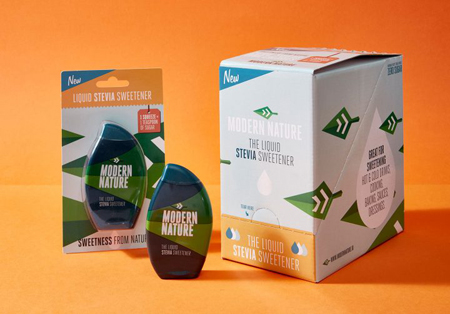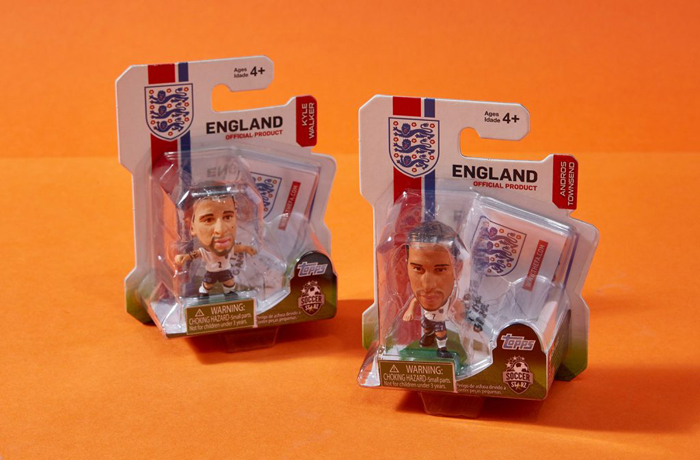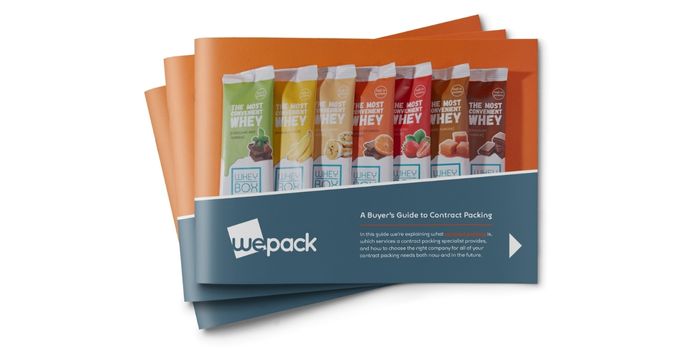
Blister packaging and clam packaging what they are and why your business should be using them

What is blister packaging?
Blister packaging is a type of packaging produced by heating a sheet of plastic and moulding it into shape to form a bubble or pocket the ‘blister’ that completely covers the product.
A traditional blister pack is known as a face seal blister and has a cardboard back. The plastic blister is fixed to the front of the cardboard, to contain and protect the product. You can read more about the different types of blister packaging below.
The blister can be made in any shape a uniform shape to protect tablets, for example, or an unusual shape to protect a less consistently shaped product, like the football figurines shown in the image below.
Tell WePack about your project!

What products do blister packs suit?
Some products typically packaged with blister packs include:
- electronic goods and accessories (e.g. USB drives, cables, headphones)
- toys
- stationery (e.g. pens, drawing pins, paper clips, superglue)
- batteries
- toothbrushes and dental floss
- DIY goods (e.g. screws, nails, nuts and bolts)
- tablets and capsules
- products with delicate parts
- products that are vulnerable to breaking (e.g. printer ink cartridges)
Blister packaging is all about protecting the product. If the product’s shape makes certain parts of it vulnerable—for example, the arm of the football figurines in the picture above—blister packaging can protect it in a way that a bag or box can’t.
Blister packs also keep products clean and uncontaminated, which is why they are almost always used to package tablets.
They are also tamper-proof. In other words, if someone has tampered with a pack of tablets (e.g. removed some of the contents), you’d be able to see that clearly from a break in the packaging.
What types of blister packaging are there?
The most common types of blister packaging are as follows:
Face seal blister
The plastic blister is moulded around the product and heat-sealed to a cardboard backing. This type of blister packaging is fairly inexpensive and so is generally used for products made in large volumes.
Full-face seal blister
The blister surrounds not only the entire product but the card backing too. The plastic is either heat-sealed to the card or slid through additional plastic pieces on each side. This type of blister packaging is used to make the packaging stronger (the corners are harder to bend, for instance) and better-looking.
Full card blister
Like the full-face seal blister, the blister covers the full size of the card. But rather than be heat-sealed to the card, it has flanges that wrap around it. The card is slid, and sometimes stapled, into place.
Trapped blister
A trapped blister is almost the same as a traditional blister pack but the plastic part that sticks to the cardboard has another piece of cardboard in front of it that fits around the shape of the blister. The plastic is then trapped between two pieces of cardboard. The top piece of card is die-cut to fit the blister where the product sits. As this type of blister packaging uses no heat-sealing methods, it’s cheaper to produce than those methods that do. This makes it more tamper-proof as it becomes obvious if the front cardboard has been ripped. It also looks better as it covers the plastic.
Clamshell
A hinged blister where two sides fold together to create a closed container. Clamshell packaging is explained in more detail below.
What is clamshell packaging?
Clamshell packaging (also called clam packaging or clam packs) is a type of blister packaging. Unlike a normal blister pack, clamshell packaging doesn’t have a cardboard back. Instead, it has a plastic back which is hinged to the front of the packaging, either at the side or the base. Some versions are made so they can stand upright on shop shelves, while others are given a hole to be hung from racks. They might have a button to snap them closed, or be heat-sealed shut. The bubble can be evenly sized on the back and front or can be a different size and shape depending on the product inside it.

A Buyer's Guide to Contract Packing
In this guide we’re explaining what contract packing is, which services a contract packing specialist provides, and how to choose the right company for all of your contract packing needs both now and in the future.
What products does clamshell packaging suit?
Clam packaging offers the same kind of protection as any other blister packaging but works best for products that won’t really fit in a blister pack, or for sets that have several different parts. For example:
- small tool sets
- sets of lightbulbs
- gift sets
- cosmetic sets
What are the advantages and disadvantages of blister packaging?
Advantages
- Visual impact: Blister packaging helps catch the consumer’s eye easily by letting the product speak for itself. Products in blister packs often stand out much better than those in boxes.
- Protection: Blister packs shield the product from damage and keep it clean. They also show when the packaging has been tampered with (unlike a box, which someone can open and close without it showing).
- Harder to steal: Blister packs particularly clam packs are often made in unusual shapes, which makes them harder for a shoplifter to conceal. This appeals to a lot of supermarket chains at present, since shoplifting is a frequent problem.
- Lightweight: Blister and clam packaging is very light, which lowers transport costs.
- Easily recycled: Clam packaging in particular is simple to recycle as it’s made purely of plastic.
- Helps with following routines for medication: The packaging can be marked so each little pocket holding a tablet or pill is numbered or listed by days. It also helps people monitor how many pills they’ve taken, unlike bottles.
Disadvantages
- tends to cost more than alternative packaging methods
- takes more time to produce than alternatives like bottling, for example
How is blister packaging made, step-by-step?
The process of making blister packaging generally goes as follows:
- First, a heat-sealed blister is formed using an aluminium resin tool. This process can be expensive, which is why it makes most sense to pack a decent number of products when using blister packaging.
- The cardboard backing is printed, using a special printing process which has adhesive in it. When dry, it looks and feels no different to normal printed cardboard, but under heat and pressure the glue melts, meaning the plastic blister can stick to it.
- The blister is placed into a specialised part of the sealing machine, known as the sealing jig. The product is placed into the blister and the card is added.
- The jig is rotated on a turntable and a hot metal plate is applied.
- Pressure is applied to the plate to seal the blister to the card.
- The turntable is rotated again, the final blister pack is removed and packed into outer packaging for distribution.
Watch a longer process from the series “how it’s made”.
How does the cost of blister and clam packaging compare to alternatives?
Blister packing is not a low-cost option!
Producing a traditional blister pack is quite expensive to set up compared to a single carton. However, if a large number of units are to be packed, these costs can be spread across many products.
Clamshell packaging, on the other hand, can often be sourced as an “off the shelf” product. There are many companies who offer a selection of moulds and a range of standard sizes. This saves on set-up costs, and if used well, can be a very competitive option.
What type of plastic is blister packaging normally made of?
Generally, PET (polyethylene terephthalate) is used because it’s transparent, strong and holds its shape well. PVC (polyvinyl chloride) is slightly less transparent and can sometimes appear a little yellow.
Can blister packs be recycled?
As blister packs typically consist of PET or PVC and aluminium, they can be more difficult and costly to recycle as the different materials must be separated. Many local councils do now recycle blister packs, while there are others that don’t. It’s always worth checking before throwing anything away.
Empty blister packs for tablets/pills aren’t recyclable, so you’ll need to dispose of these with your normal rubbish. You can recycle the cardboard box that the blister packs of tablets came in, however.
Are there biodegradable types of blister/clamshell packaging?
Some companies have been able to produce plastic-free, environmentally friendly blister packaging, but this is yet to be widely used across the packaging industry.

